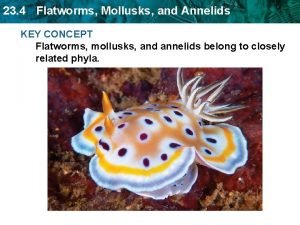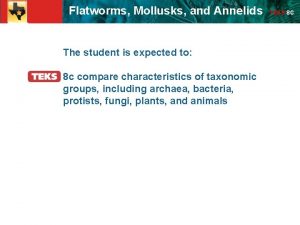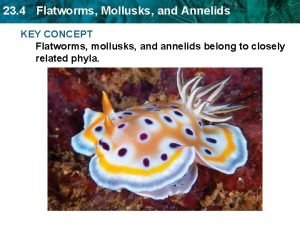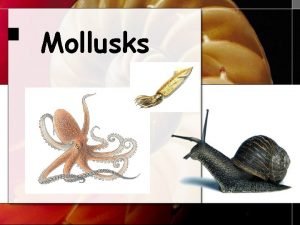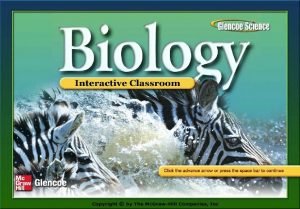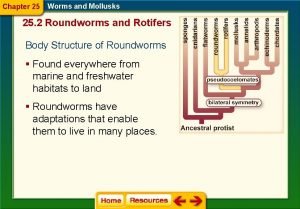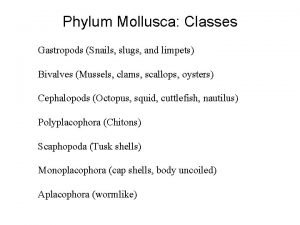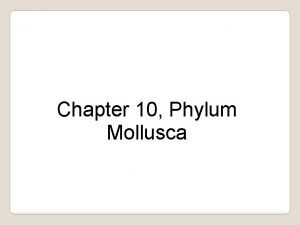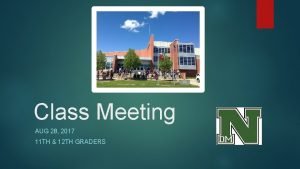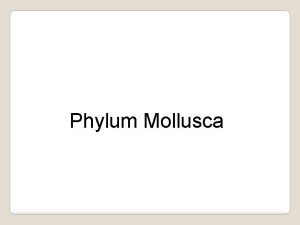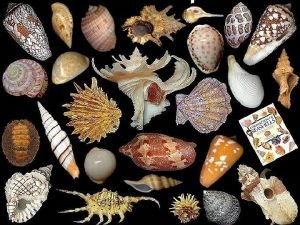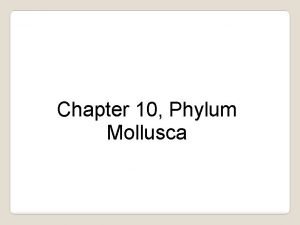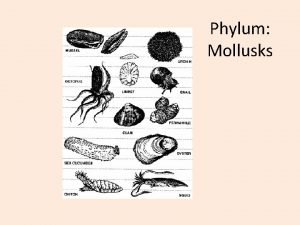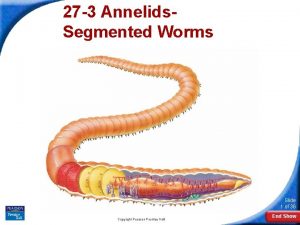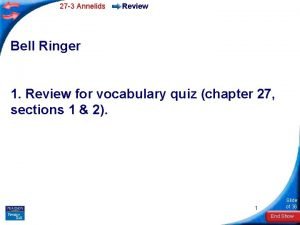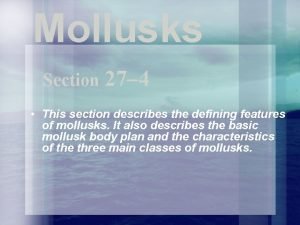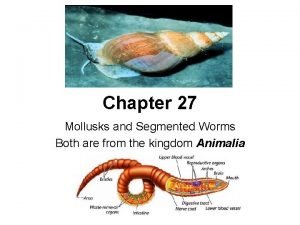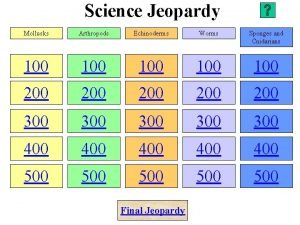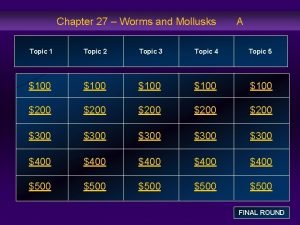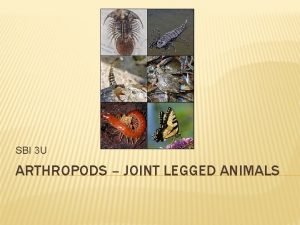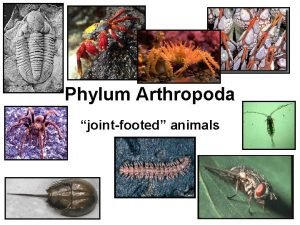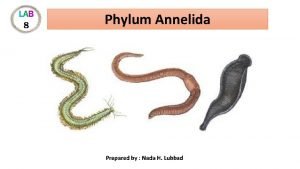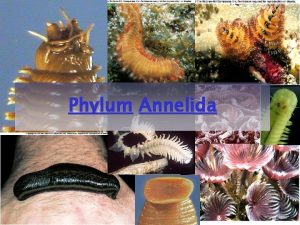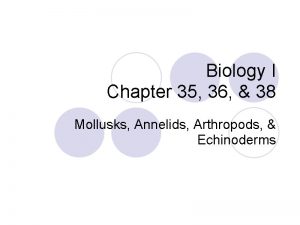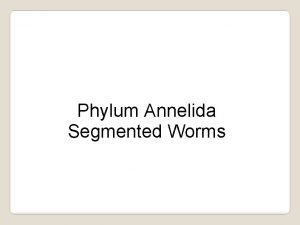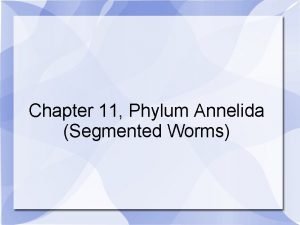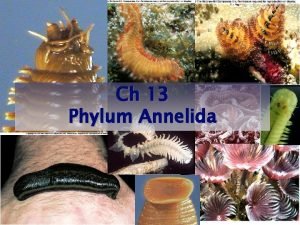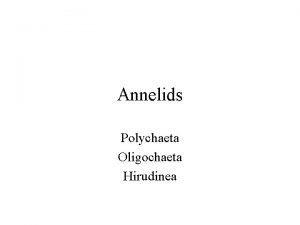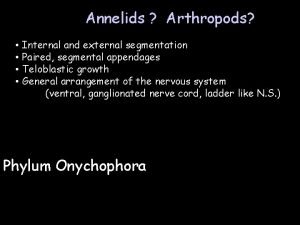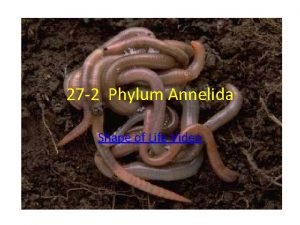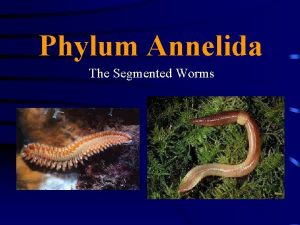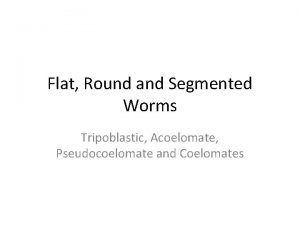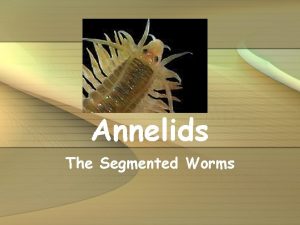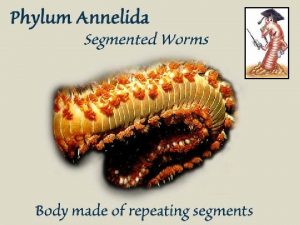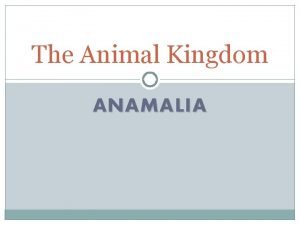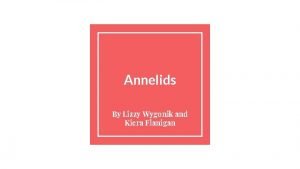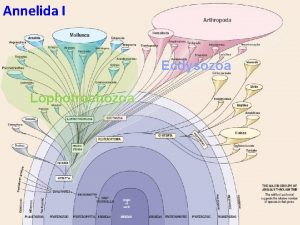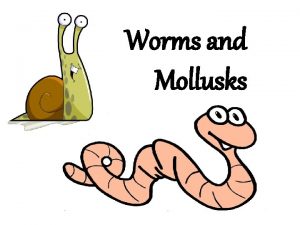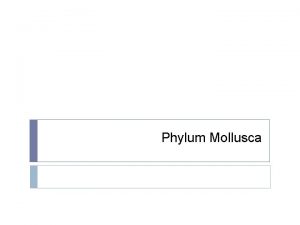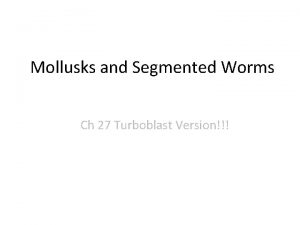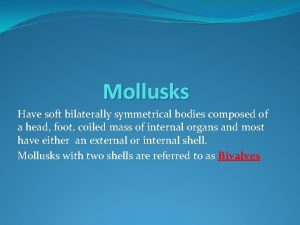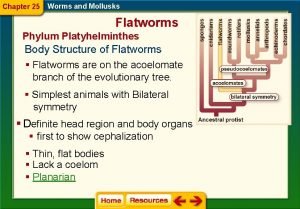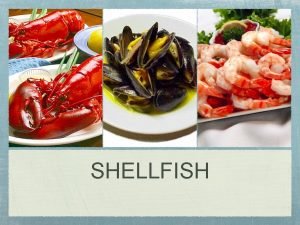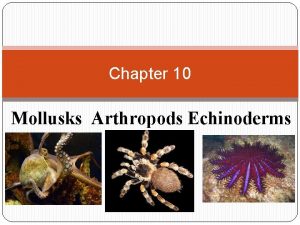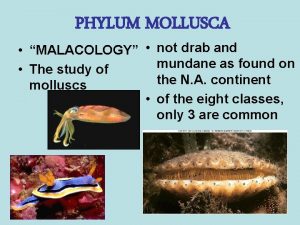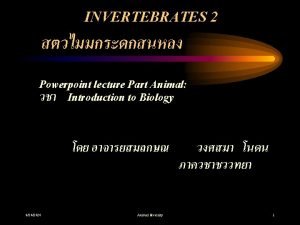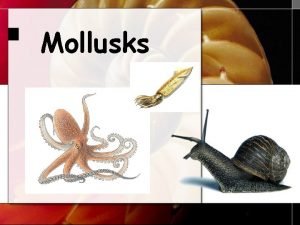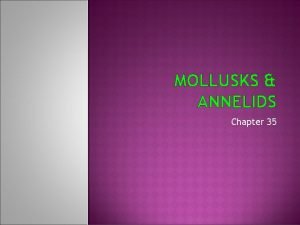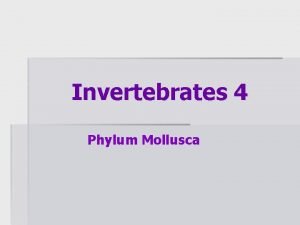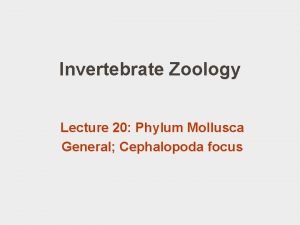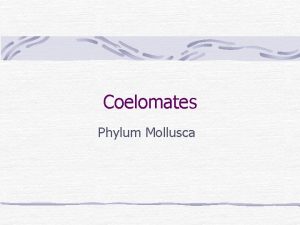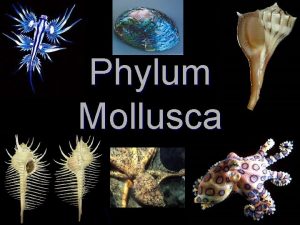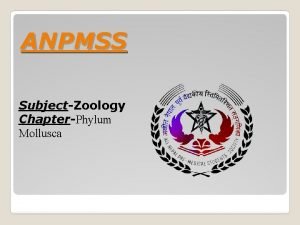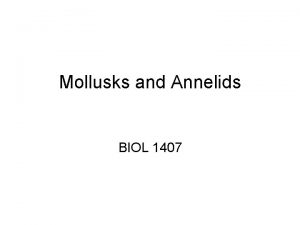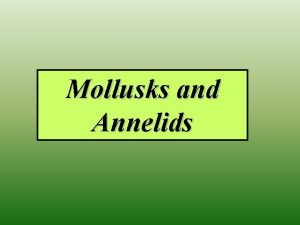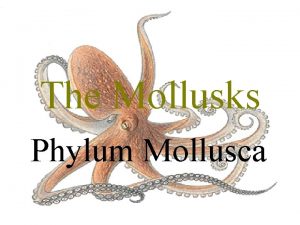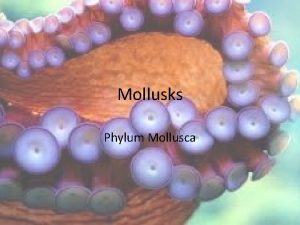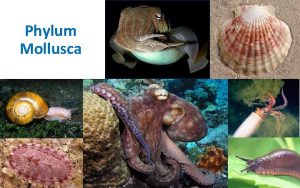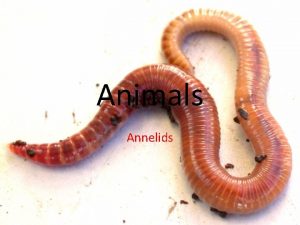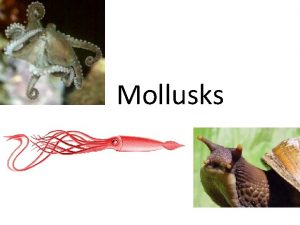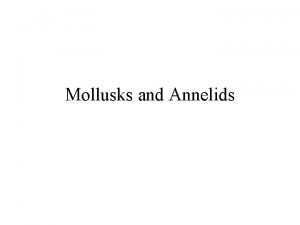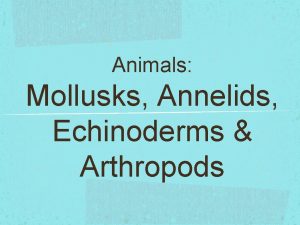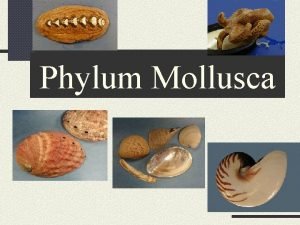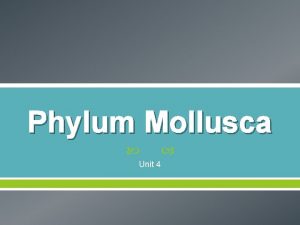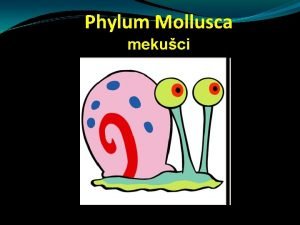MOLLUSKS ANNELIDS Chapter 35 PHYLUM MOLLUSCA Section 35


























































- Slides: 58

MOLLUSKS & ANNELIDS Chapter 35

PHYLUM MOLLUSCA Section 35. 1 Video

PHYLUM MOLLUSCA Means “soft body” Most marine, some freshwater, a few terrestrial

Terrestrial Fresh Water MOLLUSK EXAMPLES Marine

COELOM Definition: a body cavity that is completely lined by mesoderm and contains internal organs Found in the following phlya: Mollusca (clams) Arthropoda (crayfish) Echinodermata (starfish) Chordata (humans) Annelida (earthworms)

LARVAL STAGE Trochophore: larval stage of development for aquatic mollusks and annelids Use cilia for swimming and feeding Some have a hard shell for protection

BODY PLAN: Body divided into 2 main section: headfoot & visceral mass: Head-foot: head (mouth, sensory structures) and foot (locomotion) Visceral mass: heart & digestive, excretion, and reproductive organs Covered by the mantle


OTHER BODY PARTS: Mantle: layer of epidermis that excretes a hard shell of calcium carbonate Mantle cavity: space between mantle and visceral mass that protects the gills Ganglia: clustered nerve cells that control locomotion & feeding Radula: flexible, tongue-like strip of tissue covered with abrasive teeth

Video

• radula – rasping “tongue” of chitin

3 MAIN CLASSES 1. 2. 3. Class Gastropoda Class Cephalopoda Class Bivalvia

GASTROPOD EXAMPLES (Snails, nudibranchs, cowries, whelks)

CLASS GASTROPODA Largest and most diverse group of mollusks Examples: snails, abalones, conchs, slugs Locomotion: wavelike muscular contractions on mucus slime trail Can withdraw head into mantle cavity when threatened Video

OPEN CIRCULATORY SYSTEM Hemolymph: circulatory fluid Hemocoel: fluid filled spaces A. k. a. blood cavity

GASTROPODS, CONT. tentacles- sense touch & have eyes on ends respire with gills (aquatic) or exposed blood vessels (terrestrial) by diffusion we eat muscular foot “escargot”

YUMMY FOOT!


MORE GASTROPODS!


SLUGS


• shoot, then inseminate • (mucus paralyzes female reproductive tract) • successful darters double success

CLASS CEPHALOPODA Examples: octopuses, squids, cuttlefishes, chambered nautiluses Marine animals, free swimming Meaning “head-foot”

CEPHALOPODS CONT. Tentacles have large suction cups Largest invertebrate brain Highly advanced eyes similar to humans Closed circulatory system Many release dark, inky fluid when alarmed Many have pigment cells called chromatophores for camouflage Video

CEPHALOPODS EXAMPLES Squid, chambered nautilus, cuttlefish, octopus Video

CLASS BIVALVIA Examples: clams, oysters, mussels, scallops All have a two part shell connected by hinge closed by adductor muscles aged by shell rings sedintary filter feeders Video

FILTER FEEDERS 2 siphons at the posterior end: Incurrent siphon = intake of water & food Excurrent siphon = output of water & wastes Clams dig in the soil so only their siphons stick out Filters Video about 3 quarts an hour!

Video

PEARLS Calcium carbonate secretion around a foreign object Protection of the soft visceral mass Made by the mantle (just like the shell)

------ protective outer layer /////// ------ prismatic layer pearly layer


WHY WOULDN’T THE OYSTER GIVE ANYONE HIS PEARL ? He Was Shellfish

CLAM DISSECTION Body parts you MUST identify & show me during the lab: Umbo Valves (shells) Mantle Gills Incurrent & excurrent siphons Palps & mouth Digestive gland Intestine Gonads Heart

clam Oldest part

DORSAL ANTERIOR POSTERIOR VENTRAL



PHYLUM ANNELIDA Section 35. 2

CHARACTERISTICS Examples: earthworms, leeches Annelid means “Little rings” Segmentation allows for division of labor Bilateral symmetry Live in freshwater, marine water, and terrestrial environments


CLASS DIVISION: Setae: external bristles Parapodia: fleshy protrusions on outside of body Number of setae and parapodia divides this phylum into three class: Class Polychaeta 2. Class Hirudinea 3. Class Oligochaeta 1.

CLASS POLYCHAETA “Many bristles” Number of setae and parapodia Have anetennae & specialized mouth parts Most are marine animals Trochophore larvae Predatory Largest class of annelids Video


CLASS HIRUDINEA Smallest class of annelids Example: leeches Live in calm freshwater & moist vegetation No setae or parapodia Most are carnivores & some are parasitic Secrete anaestheic & anticlotting factors Ingest 10 times it own weight in blood!

CLASS OLIGOCHAETA “Few bristles” Few setae and no parapodia Live in soil or freshwater Example: earthworms


STRUCTURE & MOVEMENT Divided into over 100 segments Movement: Anchor middle segments with setae Contract muscles in front Elongation of anterior Setae of anterior grip ground Pull posterior forward


FEEDING & DIGESTION: Ingest soil as they burrow Digestion path: mouth esophagus crop (temp. storage) gizzard (releases & breaks up organic matter) long intestine (absorption of nutrients) anus

CIRCULATION: Closed circulatory system Ventral (toward posterior) & dorsal (toward anterior) vessels Aortic arches link ventral and dorsal vessels

RESPIRATION & EXCRETION: Respiration: diffusion of oxygen and carbon dioxide via moist skin Secretion of mucus to keep moist Excretion: via nephridia (excretory tubules in every segment except first three)

NEURAL CONTROL: Chain of ganglia connected by a ventral nerve cord Each segment has a single ganglia Brain = fused ganglia Simple sensory skills Light Touch Chemicals temperature

REPRODUCTION: Hermaphrodites Cannot fertilize own self Mating: press ventral surfaces together, anterior ends pointed opposite directions Setae hold worms together Mucus secretion from clitellum Each worm injects sperm into mucus Sperm going into seminal receptacles of other worm Several days later chitin tube forms picking up eggs & stored sperm fertilization Young worms develop inside tube and hatch 2 -3

BENEFITS TO ECOSYSTEM: Decomposers of leaves and organic matter Recycle nutrients Release natural fertilizers (waste) Aerates the soil

WORM DISSECTION:


 Section 4 flatworms mollusks and annelids
Section 4 flatworms mollusks and annelids Section 4 flatworms mollusks and annelids
Section 4 flatworms mollusks and annelids Section 4 flatworms mollusks and annelids
Section 4 flatworms mollusks and annelids Mollisca
Mollisca Vampire squid
Vampire squid Chapter 25 section 3 mollusks
Chapter 25 section 3 mollusks Limpets phylum
Limpets phylum Phylum mollusca characteristics
Phylum mollusca characteristics Phylum mollusca homework and study guide #1
Phylum mollusca homework and study guide #1 Gastropoda characteristics
Gastropoda characteristics Ciri ciri kelas cephalopoda
Ciri ciri kelas cephalopoda Mollusca
Mollusca Phylum mollusca characteristics
Phylum mollusca characteristics 3 groups of mollusks
3 groups of mollusks Section 27-3 annelids
Section 27-3 annelids Section 27-3 annelids
Section 27-3 annelids Excretory organ of annelids
Excretory organ of annelids This section describes
This section describes Mollusks
Mollusks 5 advanced characteristics shared by cephalopods
5 advanced characteristics shared by cephalopods The most active mollusks are the
The most active mollusks are the Arthropods are jointed-legged animals. spiders crabs
Arthropods are jointed-legged animals. spiders crabs Joint footed animals
Joint footed animals Spider phylum
Spider phylum Annelida
Annelida Prostomium
Prostomium Annelids
Annelids Do worms reproduce sexually or asexually
Do worms reproduce sexually or asexually Cross section of an earthworm
Cross section of an earthworm The characteristics of annelids
The characteristics of annelids Annelida characteristics
Annelida characteristics Hirudinea parapodia
Hirudinea parapodia Annelids vs arthropods
Annelids vs arthropods Annelida function
Annelida function Annelida
Annelida Aceolomates
Aceolomates Are annelids acoelomates
Are annelids acoelomates Segmented worm characteristics
Segmented worm characteristics Proterostomes
Proterostomes Anamalia
Anamalia Symmetry in annelids
Symmetry in annelids Are annelids ecdysozoa
Are annelids ecdysozoa Mollusks characteristics
Mollusks characteristics Mollusca
Mollusca Segmentation in mollusca
Segmentation in mollusca Are mollusks symmetrical
Are mollusks symmetrical Are worms mollusks
Are worms mollusks Two classification of shellfish
Two classification of shellfish Mollusks tongue
Mollusks tongue Mollusca bilateral symmetry
Mollusca bilateral symmetry Label the external structures of the insect below
Label the external structures of the insect below Arthropods characteristics
Arthropods characteristics Mollusca
Mollusca Cephalopod phylum
Cephalopod phylum Visceral mass
Visceral mass Peristaltic movement
Peristaltic movement Mollusca body plan
Mollusca body plan Mollusca
Mollusca Mollusca
Mollusca
